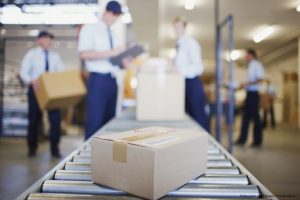by LaurenL | Sep 30, 2016
 Using renewable energy is a hot topic in the waste management industry, but it’s one that many people know less about than they think. Sure, we all recognize the most common renewable energy sources, like solar power and wind energy. But, there are many other types of renewable energy that aren’t quite as common knowledge. Did you know that sewage waste is now being used to heat and cool buildings? Or, that wasted food is used to generate electricity? Our waste has increasingly become a valuable way to replace non-renewable energy sources. Here are a few surprising examples:
Using renewable energy is a hot topic in the waste management industry, but it’s one that many people know less about than they think. Sure, we all recognize the most common renewable energy sources, like solar power and wind energy. But, there are many other types of renewable energy that aren’t quite as common knowledge. Did you know that sewage waste is now being used to heat and cool buildings? Or, that wasted food is used to generate electricity? Our waste has increasingly become a valuable way to replace non-renewable energy sources. Here are a few surprising examples:
1. Biomass
Biomass, organic materials like scrap lumber, forest debris, crops, and manure, can be used as fuel to create electricity or other forms of power. This type of waste, which generally comes from demolition, construction, or farming practices, can be burned to create heat. In biomass power plants, this heat is harnessed and used to heat industries and homes, or it is used to produce steam. The steam from burning biomass fuel is used to run turbines to make electricity.
2. Sewage
There is a near constant stream of warm sewage that comes from the biomatter, dishwashers, showers, and industrial processes that produce hot water and send it down the drain. Researchers in China have found ways to capture this heat and use it to regulate temperature inside buildings. In Philadelphia, this technology has been installed at the Southeast Wastewater Treatment Plant. Using only sewage and wastewater, a 20,000 square foot compressor building at the plant is fully heated and cooled by the system.
3. Landfill Gas
The life cycle of your garbage doesn’t end when it’s dumped at the landfill. Instead, once there, the decomposition of solid waste begins to produce a byproduct that can be used in surprising ways. Methane gas, a by-product of garbage decomposition, is collected at landfills and used as thermal energy, to generate electricity, or to do both at the same time. Landfill gas is also being used as an alternative to fossil fuels like natural gas.
4. Waste Heat
Major data centers, like IBM’s Zurich Research Laboratory, use water to cool down its servers. Once the water has done its job, these centers are left with hot water that is often treated as waste heat. Now, instead of disposing of this waste, it is being used to heat nearby homes. Much like hot sewage is used to warm buildings, other forms of waste heat, like that produced when cooling machinery, can be used to generate alternative heating and cooling systems.
5. Food Waste
Heartland Biogas Project in northern Colorado is just one example of an organization that is finding ways to use food waste to create energy. They, like many others, collect millions of gallons of food waste and combine it with anaerobic digesters. These digesters are bacteria that break down the waste. In the process, they give off methane. This methane is a powerful gas used to generate electricity and other forms of renewable energy.
How KenBay Can Help You Manage Your Waste
Whether or not your business produces waste that can be used as a renewable energy source, we know waste management can be a burden. Because trash compactors will reduce the weight and size of your waste, they are a great way to cut down your waste removal costs and improve the efficiency of waste management.
Trash compactors like KenBay’s RotoPac are ideal for industrial settings, and allow companies to reduce the volume of their trash at a ratio of six to one. The RotoPac can handle all kinds of waste from food to recyclables, and even solid hazardous waste.
Don’t let something like a waste get in the way of your business operations. If you’re interested in trash compactors or finding a committed consultant to help you reduce your waste, call KenBay. We can tell you more about our services, no matter what industry you’re in, or how much waste you are creating!
Photo credit: Getty Images / NicoElNino
by LaurenL | Sep 23, 2016
 Waste. It’s something every business creates, but few know how to reduce. For many manufacturers, a surprising source of waste is found in the supply chain. For others, it’s found in a number of different places. No matter the cause of your waste, it is important to understand where it’s coming from. Why? Because understanding where your business produces the most waste is the first step to finding ways to reduce it.
Waste. It’s something every business creates, but few know how to reduce. For many manufacturers, a surprising source of waste is found in the supply chain. For others, it’s found in a number of different places. No matter the cause of your waste, it is important to understand where it’s coming from. Why? Because understanding where your business produces the most waste is the first step to finding ways to reduce it.
Do you ever get the feeling that your business might be spending more time, energy, or money on waste management than it should be? If so, let us help you find a solution to your waste management concerns. To start, we recommend evaluating your supply chain. It’s filled with surprising sources of waste.
1. Raw Materials
You should evaluate your processes from the very beginning, before you every start production on a supply chain. Why? Because your raw materials might be a source of waste. One way to reduce waste in the supply chain is to take a second look at your raw materials. Do your raw materials have excess packaging or unusable components? Can you use a less wasteful alternative? How do you use excess raw materials? If they’re thrown out, what can you do to reduce that amount? Every production process should work to minimize the waste associated with raw materials. Whether you reduce, reuse, or recycle materials, there are ways to minimize your supply chain waste by evaluating your raw materials.
2. Inventory Control
Just like managing the input of raw materials into your supply chain can reduce waste, evaluating the output of your supply chain can, too. Overproduction in your supply chain produces excess waste. This is especially true if extra products are abandoned, unused on a shelf in a warehouse. Overproduction has the potential to cause wasted materials and final products. But, it also wastes money and resources that are required to store, maintain, or get rid of unnecessary inventory. Having too much inventory on hand often ties up valuable resources and creates wasteful processing tasks.
3. Defects and Quality Control
It goes without saying that one goal for manufacturers is watching the perfect product roll off the assembly line every time. In reality, however, this is rarely the case. Defective products that don’t pass quality control inspections happen. But, don’t overlook defective products. They are an oft-forgotten source of waste in the supply chain. Ensure that you keep the goal of minimizing defective products on your supply chain in mind. Improved quality control will reduce waste every time.
KenBay Can Help You Manage Supply Chain Was
We know waste management can be a burden. But, it doesn’t have to be! With our help you can evaluate your supply chain for hidden sources of waste and implement technology to reduce it. Because our trash compactors will reduce the weight and size of your waste, they are a great way to cut down your waste removal costs and improve the efficiency of waste management.
Trash compactors like KenBay’s RotoPac are ideal for industrial settings, and allow companies to reduce the volume of their trash at a ratio of six to one. The RotoPac can handle all kinds of waste from food to recyclables, and even solid hazardous waste.
Don’t let something like a waste get in the way of your business operations. If you’re interested in trash compactors or finding a committed consultant to help you reduce your waste, call KenBay. We can tell you more about our services, no matter what industry you’re in, or how much waste you create!
Photo credit: Getty Images / Paul Bradbury
by LaurenL | Sep 16, 2016
 So, you throw away your garbage, it’s picked up by a waste management company, and then it’s delivered to a landfill where it sits to rot into eternity, right? Wrong. Allow us to introduce you to landfill gas. The life cycle of your garbage doesn’t end when it’s dumped at the landfill. Instead, once there, the decomposition of solid waste begins to produce methane gas. What’s methane gas? A colorless, odorless, gas that is all around you. It’s also a by-product of garbage decomposition. And, it can be put to use in surprising ways.
So, you throw away your garbage, it’s picked up by a waste management company, and then it’s delivered to a landfill where it sits to rot into eternity, right? Wrong. Allow us to introduce you to landfill gas. The life cycle of your garbage doesn’t end when it’s dumped at the landfill. Instead, once there, the decomposition of solid waste begins to produce methane gas. What’s methane gas? A colorless, odorless, gas that is all around you. It’s also a by-product of garbage decomposition. And, it can be put to use in surprising ways.
Why is this important? Because, according to the United States Environmental Protection Agency (EPA), “[c]onverting LFG to energy offsets the need for non-renewable resources such as coal and oil, and reduces emissions of air pollutants that contribute to local smog and acid rain.” And, that’s something we can all appreciate.
How Landfill Gas is Used
Methane, also known as landfill gas, can be captured in landfills and converted into a useable energy source. Instead of vanishing into the air, a system of wells, blowers, or vacuums collect landfill gas and take it to a processing facility. Depending on the facility the landfill gas is delivered to, it will be put to use in different ways. Here are a few of them:
1. Electricity Generation
In the United States, most captured landfill gas (about 75%) is used to generate electricity. The landfill gas to electricity process starts deep inside the pile of waste. To collect the gas, a vacuum-like blower captures it from the center of the garbage heap. After that, the gas is transported through a pipework system from the garbage heap to a processing facility, where it is transformed into electrical energy. Typically, the electricity created at landfills is used on-site, but it is also sold to the grid for general use.
2. Direct Use as Thermal Energy
Landfill gas is also used to offset, or replace, the use of other types of fuel. Instead of natural gas, coal, or fuel oil, landfill gas can be used as thermal energy. This fuel is utilized in boilers, dryers, kilns, greenhouses, and other machines that rely on thermal energy. Landfill gas can be used to fire pottery and glass, heat water for aquaculture (fish farming), and warm greenhouses. Other industries that currently use landfill gas include auto manufacturing, chemical production, food processing, pharmaceuticals, cement and brick manufacturing, wastewater treatment, consumer electronics and products, paper and steel production, and prisons and hospitals.
3. Cogeneration
Not only is landfill gas used to generate electricity or thermal energy, sometimes it is used to produce both! Because this process generates two types of energy at once, it is aptly called cogeneration. In this process, landfill gas is used in engines and turbines to produce both heat and power, typically in the form of hot water or steam.
4. Alternative Fuels
Using landfill gas as an alternative fuel is one of the newest ways it is being put to use. Because landfill gas is produced all-day, every day, and will continue to be produced for as long as we have decomposing garbage, it is often viewed as a renewable energy source to be used in place of fossil fuels. Just one example, landfill gas can be used as the equivalent of natural gas, a nonrenewable energy source that will one day run out.
How KenBay Can Help You Manage Your Waste
Whether your business has made the switch to zero waste, or it contributes to the production of landfill gas, we know waste management can be a burden. Because trash compactors will reduce the weight and size of your waste, they are a great way to cut down your waste removal costs and improve the efficiency of waste management.
Trash compactors like KenBay’s RotoPac are ideal for industrial settings, and allow companies to reduce the volume of their trash at a ratio of six to one. The RotoPac can handle all kinds of waste from food to recyclables, and even solid hazardous waste.
Don’t let something like a waste get in the way of your business operations. If you’re interested in trash compactors or finding a committed consultant to help you reduce your waste, call KenBay. We can tell you more about our services, no matter what industry you’re in, or how much waste you are creating!
by LaurenL | Sep 9, 2016
 There’s one question that every business asks when it considers becoming a zero waste organization: how will this affect our bottom line? For many skeptics, the assumption is that “going green” costs money. We are here to tell you that these assumptions are wrong. Zero waste companies, ones that implement measures to keep their waste out of landfills, often find that saving money and being environmentally friendly can go hand in hand. To help you understand how you can implement zero waste programs into your business and save money, here are a few of our best tips:
There’s one question that every business asks when it considers becoming a zero waste organization: how will this affect our bottom line? For many skeptics, the assumption is that “going green” costs money. We are here to tell you that these assumptions are wrong. Zero waste companies, ones that implement measures to keep their waste out of landfills, often find that saving money and being environmentally friendly can go hand in hand. To help you understand how you can implement zero waste programs into your business and save money, here are a few of our best tips:
Ensure Your Equipment is Reliable and Safe
It goes without saying that unsafe working conditions lead to a number of problems. But, it’s often worth repeating. When you begin a zero waste initiative, you will likely look for new tools and equipment to help you in your pursuit. Whether you implement new equipment or continue to use your existing tools, ensure that your equipment is reliable and safe. Addressing safety concerns and expensive maintenance and repairs will cost you money and will hurt your bottom line. To avoid this problem, be sure that the machinery and equipment your zero waste business uses is the most reliable on the market. The less time, energy, and resources spent on repairs and updates, the more cost efficient you will be in your pursuit of zero waste.
Evaluate the Efficiency of Your Tools
If we’ve said it once, we’ll say it again, ineffective tools will cost you money. How does this tip differ from what we’ve already mentioned? Glad you asked. Evaluating the efficiency of your tools is much more than just being aware of their reliability and safety. Even if the machinery you use, or may implement in zero waste initiatives, is reliable, safe, and low maintenance, ask yourself this: Is it also efficient? If you were building your processes today, would you choose this the machinery? Does your equipment get the job done quickly? Are there other options on the market that do the job better and faster? Plain and simple, wasting time wastes money. When you pursue zero waste initiatives, seek out the time and money saving options available to you. Stay vigilant and do your research to make sure that the tools you use are the most efficient ones on the market.
Consider Labor Costs
When you reduce the time it takes to get a job done, you also reduce your labor costs associated with the task. For many businesses, this reduction in transportation and labor costs is the easiest way to save money in the pursuit of zero waste. From the first step of your operation to the last, evaluate your procedures and always be on the lookout for ways to minimize your labor costs. Can a task be performed faster? Is there a tool on the market that will make labor easier to complete in a timely fashion? Being mindful of these questions will help your business save money that might be spent unnecessarily on labor costs. This is another strategy for saving money that you can implement in your business when you pursue a zero waste initiative.
Let Us Help You Save Money in Your Pursuit of Zero Waste
With KenBay, you can minimize costs and save money at the beginning of waste management. KeyBay’s commercial trash compactor models offer a safe, reliable, easy to use option for compacting waste before transport, thus saving you money in your pursuit of zero waste. Our RotoPack trash compactors address all the money saving tips we’ve suggested for you.
1. Reliability and Safety
The RotoPac trash compactor by KenBay is easy to use, made of quality construction, and implements several key safety measures. Because of this, you will save money on the safety and maintenance costs associated with trash compacting.
2. Efficiency
The RotoPac is small enough to place directly at the source of your waste. Instead of transporting waste elsewhere, you can compact it right away, saving you time, energy, and ultimately money. In addition, the RotoPac allows for more efficient, continuous trash compacting. Never again will production halt because of waiting time at the trash compactor.
3. Reduced Labor Costs
Although the RotoPac is smaller than traditional trash compactors, it compacts trash at such a rate that you don’t need to empty the compactor as often. In addition, trash is compacted more tightly in a RotoPac than in a traditional compactor. This tight compaction means you can fit more waste into a single bag and make fewer trips to dispose of waste. A trash compactor like the RotoPac that allows you to spend less time collection and transporting waste will reduce your labor costs and raise your cost efficiency.
KenBay produces innovative equipment that maximizes safety and sustainability and minimizes the financial and global impact of solid industrial waste removal. Heavy hitters like the U.S. Navy, Purolator, and Boeing use our cost and work efficient tools daily. We’ve helped these organizations improve their efficiency and save money. Now, we can help your business do the same. Contact us today!
 Using renewable energy is a hot topic in the waste management industry, but it’s one that many people know less about than they think. Sure, we all recognize the most common renewable energy sources, like solar power and wind energy. But, there are many other types of renewable energy that aren’t quite as common knowledge. Did you know that sewage waste is now being used to heat and cool buildings? Or, that wasted food is used to generate electricity? Our waste has increasingly become a valuable way to replace non-renewable energy sources. Here are a few surprising examples:
Using renewable energy is a hot topic in the waste management industry, but it’s one that many people know less about than they think. Sure, we all recognize the most common renewable energy sources, like solar power and wind energy. But, there are many other types of renewable energy that aren’t quite as common knowledge. Did you know that sewage waste is now being used to heat and cool buildings? Or, that wasted food is used to generate electricity? Our waste has increasingly become a valuable way to replace non-renewable energy sources. Here are a few surprising examples: 

 Waste. It’s something every business creates, but few know how to reduce. For many manufacturers, a surprising source of waste is found in the supply chain. For others, it’s found in a number of different places. No matter the cause of your waste, it is important to understand where it’s coming from. Why? Because understanding where your business produces the most waste is the first step to finding ways to reduce it.
Waste. It’s something every business creates, but few know how to reduce. For many manufacturers, a surprising source of waste is found in the supply chain. For others, it’s found in a number of different places. No matter the cause of your waste, it is important to understand where it’s coming from. Why? Because understanding where your business produces the most waste is the first step to finding ways to reduce it. So, you throw away your garbage, it’s picked up by a waste management company, and then it’s delivered to a landfill where it sits to rot into eternity, right? Wrong. Allow us to introduce you to landfill gas. The life cycle of your garbage doesn’t end when it’s dumped at the landfill. Instead, once there, the decomposition of solid waste begins to produce methane gas.
So, you throw away your garbage, it’s picked up by a waste management company, and then it’s delivered to a landfill where it sits to rot into eternity, right? Wrong. Allow us to introduce you to landfill gas. The life cycle of your garbage doesn’t end when it’s dumped at the landfill. Instead, once there, the decomposition of solid waste begins to produce methane gas.  There’s one question that every business asks when it considers becoming a zero waste organization: how will this affect our bottom line? For many skeptics, the assumption is that “going green” costs money.
There’s one question that every business asks when it considers becoming a zero waste organization: how will this affect our bottom line? For many skeptics, the assumption is that “going green” costs money. 